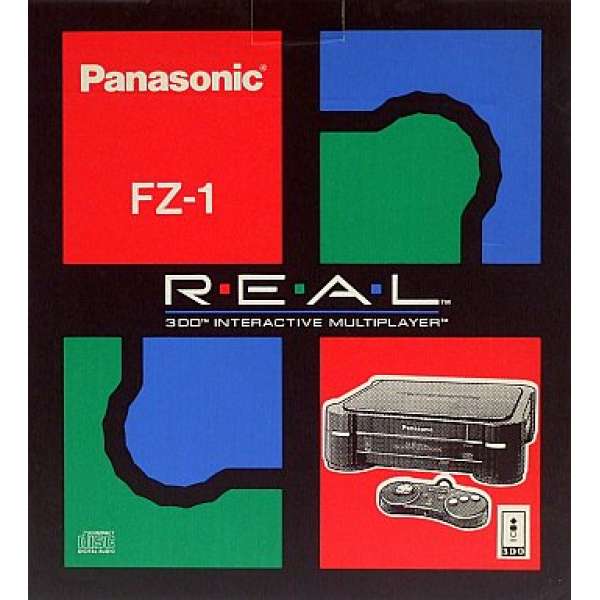3DO REAL主機 FZ-1
早期在任天堂1983年推出8位元紅白機,並搭配許多遊戲開發商作品後,快速稱霸家用遊戲市場,直到1988年SEGA不甘示弱的推出16位元主機,強勢搶回市佔率。而1990年任天堂推出超級任天堂後,又取得龍頭寶座。前EA遊戲開發商的創辦人之一特里普·霍金斯(Trip Hawkins)在1992年成功結合松下電器、AT&T、時代華納(Time Warner)、MCA、EA等一起成立3DO公司,在1993年初代主機以當時最領先的32位元規格推出上市,並有超過百家軟體公司準備推出該平台作品,而Panasonic、三洋(Sanyo)及GoldStar(現為LG)則負責製造。
硬體規格在當時非常先進,採用32位元的ARM60 RISC CPU,運行頻率為12.5 MHz,並搭載自訂的圖形和音效處理器。內建有2 MB的DRAM和1 MB的VRAM,並配備雙倍速CD-ROM光碟機,這在當時算是較為高階的配置。能支援高達1670萬種顏色,並能處理解析度達640x480像素的影像播放,使其能夠輸出高品質的視覺效果。還配有兩個擴展插槽,可用於連接額外的周邊設備。
另一大特色是其操作系統,與多媒體整合相當順暢,且能運行多種應用程式,不僅限於電子遊戲。還支援環繞音效,並提供多種輸入輸出選項,包括S-Video、複合視頻及立體聲音頻輸出。此外,能夠連接各種控制器和配件,甚至能鏈接多個控制器以進行多人遊戲。
然而,儘管主機的規格令人印象深刻,但也有幾個重大的缺點。首當其衝的是其高昂的售價,上市時定價高達699美元,這使得它遠比市場上的其他主機如Sega Genesis和超級任天堂(SNES)要昂貴得多。另一個主要缺點是其遊戲庫的質量和數量相對有限。雖然有一些著名的遊戲,如《Gex》、《Road Rash》、《Star Control II》、《Need for Speed》和《Twisted: The Game Show》,但整體的遊戲選擇並不如其他主機來得豐富和吸引人。
此外,還缺乏強有力的第三方開發者支持。許多遊戲開發者對於高昂的售價和市場定位的疑慮,使得他們不願意投入資源為3DO開發遊戲。即使3DO具備先進的多媒體功能,但對於主要用於遊戲的消費者而言,這些功能不足以支撐其高昂的價格。
當時3DO還面臨來自其他新興主機的激烈競爭,SEGA在該主機上市的同年11月21日推出土星(SATURN)主機,Sony在與任天堂合作破局後,自行開發的32元主機PlayStation,也在同年12月3日推出,售價僅39,800日元。到1996年,3DO在市場上未能獲得顯著的成功,Panasonic最終決定停止該主機的生產。
之後公司也放棄硬體開發,並透過購併New World Computing遊戲商,專注在軟體市場,並發行幾款經典作品如《英雄無敵》及魔法門系列,但之後不堪長期虧損下,終於在2002年申請破產。雖然未能達到商業成功,但其在多媒體與遊戲整合方面的創新嘗試,仍使其成為遊戲歷史中的一個重要部分。
In the early days, after Nintendo launched the 8-bit Famicom in 1983 and collaborated with numerous game developers, it quickly dominated the home video game market. However, in 1988, SEGA, unwilling to be left behind, released its 16-bit console, aggressively reclaiming market share. In 1990, Nintendo released the Super Nintendo Entertainment System (SNES), regaining the top spot. In 1992, Trip Hawkins, one of the founders of EA, successfully combined forces with Panasonic, AT&T, Time Warner, MCA, and EA to establish the 3DO Company. In 1993, the first 3DO console was launched with the most advanced 32-bit specifications of the time. Over 100 software companies were preparing to release titles for the platform, while Panasonic, Sanyo, and GoldStar (now LG) were responsible for manufacturing the consoles.
The hardware specifications were very advanced for the time, featuring a 32-bit ARM60 RISC CPU running at 12.5 MHz and custom graphics and sound processors. It included 2 MB of DRAM and 1 MB of VRAM, and it came with a double-speed CD-ROM drive, which was considered high-end at the time. The console supported up to 16.7 million colors and could handle video playback at a resolution of 640x480 pixels, allowing it to output high-quality visual effects. Additionally, it had two expansion slots for connecting extra peripherals.
Another significant feature was its operating system, which integrated multimedia quite smoothly and could run various applications beyond just video games. The 3DO supported surround sound and provided multiple input and output options, including S-Video, composite video, and stereo audio output. It also could connect various controllers and accessories, with the ability to link multiple controllers for multiplayer gaming.
However, despite the impressive specifications, there were several major drawbacks. The most significant issue was its high price; at launch, the console was priced at $699, making it significantly more expensive than other consoles on the market, such as the Sega Genesis and Super Nintendo Entertainment System (SNES). Another major drawback was the limited quality and quantity of its game library. Although there were some notable titles like "Gex," "Road Rash," "Star Control II," "Need for Speed," and "Twisted: The Game Show," the overall selection was neither as diverse nor as appealing as those available on other consoles.
Additionally, the 3DO lacked strong third-party developer support. Many game developers were hesitant to invest resources into developing games for the 3DO due to concerns about its high price and market positioning. Even though the 3DO had advanced multimedia capabilities, these features were not enough to justify its high cost for consumers primarily interested in gaming.
At that time, the 3DO also faced fierce competition from other emerging consoles. SEGA released its Saturn console on November 21, the same year, and Sony, after a fallout with Nintendo, developed its 32-bit PlayStation console, which was launched on December 3 of the same year at a price of only 39,800 yen. By 1996, the 3DO had failed to achieve significant market success, leading Panasonic to cease production of the console.
The company subsequently abandoned hardware development and, through the acquisition of New World Computing, focused on the software market, releasing several classic titles such as the "Heroes of Might and Magic" series and the "Might and Magic" series. However, unable to sustain long-term losses, the company ultimately filed for bankruptcy in 2002. Although it did not achieve commercial success, its innovative attempts at integrating multimedia and gaming have left a lasting mark in the history of video games.
運費計算方式:
貨款滿1000元運費外加90元
貨款1000以下:買1件運費外加 60元,買2件運費外加 70元,
買3件運費外加 80元 ,買4件運費外加 90元
貨到付款外加30元手續費
外島及大陸地區運費另計
付款方式:
線上刷卡:本站採用Paypal線上刷卡
虛擬帳號匯款:屬於您專屬的虛擬帳戶,方便站長查帳使用,本站強力推薦
實體ATM匯款:請將匯款帳號記錄下來至各大銀行ATM提款機轉帳
超商條碼繳費:請列印本站提供的條碼至四大超商繳費
線上轉帳:透過玉山銀行線上ATM轉帳(此系統只支援IE瀏覽器)
貨到付款:本站採用黑貓宅急便貨到付款
其他注意事項:
如需購買線上點數卡請直接跟站長連絡,本站不提供點數卡的線上付款
-
3DO REAL主機 FZ-1
- 定 價: 59,184円
- 售 價: 0.00
- 庫存量: 0 套
- 已賣出: 0 套
 人氣指數: 0.8 / 6 顆星
人氣指數: 0.8 / 6 顆星


